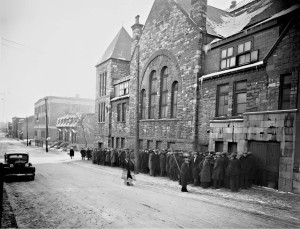Over 130 years of history
Read about the progress made in the last 25 years.

Our story
In the winter of 1889-1890, Montrealers Mina Douglas and Eva Findlay opened the soup kitchen that would become the Old Brewery Mission. It underwent its first transformation in the 1920s, when it became a shelter for men experiencing homelessness. Since then, the Old Brewery Mission has never stopped evolving.
-
1998
Opening of the Patricia Mackenzie Pavilion for women
-
2006
Inauguration of the Marcelle and Jean Coutu Pavilion, our first rental housing complex
-
2008
Launch of Le Pont-TD, our first rehousing program for homeless people in Montreal
-
2010
Opening of the Lise Watier Pavilion for women in the process of social reintegration
-
2012
Start-up of the Café Mission Keurig respite center and creation of the Annexe program, now called the Accueil program
-
2013
Launch of the PRISM-Cogeco program for mental health
-
2014
Launch of the Pause-Santé program
-
2015
Start-up of the La Traversée Grace Dart Foundation program for aging people
-
2018
Opening of the Voisines de Lanaudière relais housing for women
-
2021
Set-up of a Prevention Department and the Québec Homelessness Prevention Policy Collaborative
-
2022
Opening of the Voisines de Lartigue women’s rehousing project
-
2023
Inauguration of the Logements du Parc men’s rehousing pavilion
At the Old Brewery Mission, we are constantly modernizing our services and introducing new programs to help our clients achieve sustainable reaffiliation.
Want to help us take the next step?
Find out about all the ways you can get involved—by making a donation or giving of your time.